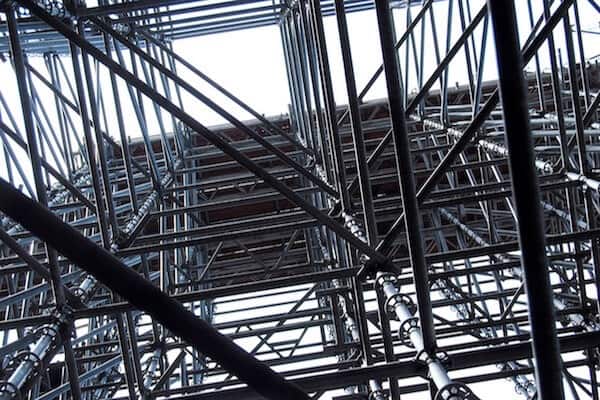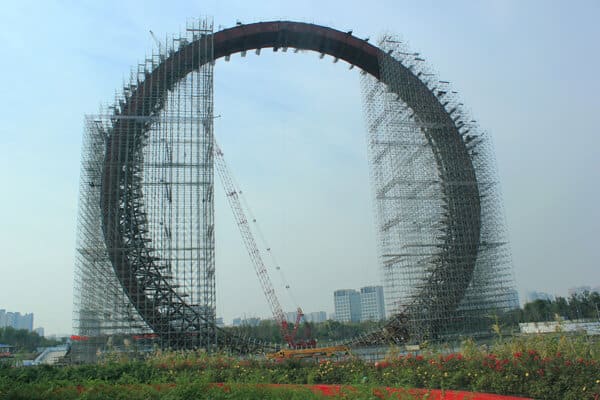Preventing fall hazards on construction sites is one of the topmost concerns of the construction industry at large. According to OSHA, fall hazards make up around 42% of all fatalities in this sector every year. OSHA also estimates that around 65% of all construction workers work on scaffolds for one reason or another each year. It is, therefore, critical to ensure the safety of such workers by determining whether or not the scaffolding is safe to use.
Ever since 1971, the Occupational Safety and Health Administration (OSHA) has put in place certain safety standards in practice for preventing scaffolding-related accidents, injuries and fatalities at construction sites.
A study by the Bureau of Labor Statistics reveals that “72% of workers injured in scaffold accidents attributed the accident either to the planking or support giving way, or to the employee slipping or being struck by a falling object.”
The use of scaffolding in construction is inevitable. It makes sense for organizations in this industry to formulate and implement essential safety practices to make work sites safer for workers.
Mitigate Scaffolding-Related Risks on Construction Sites
The measures towards achieving this include the following:
- 1. Ensuring the scaffolding has been installed by a “competent” person
- 2. Training workers adequately to use the scaffolding
- 3. Getting a sense of the load capacity
- 4. Conducting regular inspections
- 5. Making it mandatory for workers to use safety equipment
- 6. Locking scaffolding wheels when in use
- 7. Securing the platform
- 8. Ensuring only licensed workers are using the scaffolding
- Conclusion
1. Ensuring the scaffolding has been installed by a “competent” person
To ensure safe installation of the scaffolding, it is important that it is installed by a “competent” person, as defined by OSHA. An OSHA-approved competent person is “one who is capable of identifying existing and predictable hazards in the surroundings or working conditions which are unsanitary, hazardous, or dangerous to employees, and who has authorization to take prompt corrective measures to eliminate them.”
A competent person is trained and experienced; and, therefore, has comprehensive knowledge of the applicable standards, can identify workplace hazards, and has the official mandate to rectify them. He/she is also expected to meet certain additional requirements that may be required by some standards.
2. Training workers adequately to use the scaffolding
Using scaffolds safely entails assembling, moving, dismantling and maintaining them appropriately. Also, all workers using the scaffolding should know the right safety procedures, the correct use of the scaffold, and handling materials when working on it. Both these needs can be met through training (under the supervision of a competent person), which can be made mandatory.
Training should be modified as and when changes are made to the scaffolding’s structure or the task being performed. It should include identification of electrocution, prevention of hazards resulting from slips, falls, falling objects, procedures to deal with these hazards, handling materials and understanding load capacities. This brings me to the next point.
3. Getting a sense of the load capacity
A common mistake that occurs when designing a scaffolding is not considering all types of loads that it will have to endure during construction and setup. It is best to ensure that the scaffold is never overloaded or exceeds the manufacturer’s recommended load rating as this ensures the safety of everyone present at the site. Also, never overload the scaffolding with equipment or push it against the guardrails.
Special care needs to be taken when enclosing scaffolds, either partially or fully. This is crucial because the wind and changes in the weather can increase the load on the scaffolds.
4. Conducting regular inspections
Any inspection to facilitate the safe use of scaffolds must begin with an examination of a given work area. In accordance with this, the area should be checked for debris, open wires, depressions and uncovered openings. Necessary measures to mitigate them should be taken.
Before using scaffolds, inspect them for the following:
- The base and cross members should be level, adjusted and sound.
- Locking devices and ties should be secured. Planks, decks and guardrails should be installed properly.
- Appropriate-grade lumber planks should be used. They should be devoid of weak areas, fissures and corrosion.
- Legs should be upright and braces should be in their proper position.
Also, make it a point to inspect scaffolds if:
- You think their structure may have been affected due to some reason.
- Their structure is changed or altered during assembly.
- They are moved or dismantled.
During the inspection, if you find that the scaffold is defective or has been damaged in any way, avoid using it at all costs.
5. Making it mandatory for workers to use safety equipment
OSHA guidelines make it clear that workers at construction sites are required to use fall protection such as a safety harness or a belt connected to a strong, stable structure. These guidelines are to be followed by all workers involved in erecting and working on the scaffolding.
Those working under a scaffold or in an area where there is a risk of hazards resulting from falling debris should wear a sturdy hat. Wearing a life vest is a must for workers using a scaffolding over water, like in a shipyard. Also, wearing non-slip footwear can help workers stay safe.
6. Locking scaffolding wheels when in use
It is crucial to lock the scaffolding wheels when it is in use to prevent any undesired movement, which may lead the scaffold to destabilize and cause terrible accidents.
Apart from this, remove anything placed on and around the scaffolds when the work shift comes to an end. There should be a minimum 10-feet distance between scaffolds and electric lines.
7. Securing the platform
A scaffold is safe for use only once it is supported by or entirely attached to a strong upright structure like a building. If it isn’t adequately secured, it may move and dislocate an end. The scaffold will become unstable.
All scaffolds come with a few kinds of brace retention or locking systems, which need to work freely when erecting or dismantling it. They should also be able to lock securely to prevent the brace from dislocating.
8. Ensuring only licensed workers are using the scaffolding
As per OSHA, employees who do not adhere to the set safety standards for scaffolding use can post a significant risk when using it. Many a time, unlicensed employees work on scaffoldings even though they aren’t supposed to. Instead of getting themselves licensed through proper methods, they go about performing tasks at construction and building sites. By doing so, they endanger not only the workers’ lives, but also that of the future residents of the building.
Conclusion
When it comes to accident prevention at construction sites, there is no certainty that workers will be unharmed even though safety measures are in place. Alertness is of the essence here. It is crucial that work sites across the construction project are continually inspected and reviewed in order to check for new hazards that may crop up from time to time. Be mindful of unexpected hazards and take necessary steps to eliminate them. Before the work starts, have a competent safety professional examine the scaffolding that are in use at the site. He/she will be able to recommend the necessary safety precautions. A safe work site will ensure that workers feel comfortable and confident in performing their tasks.
Featured photo credit: Pixabay via pixabay.com





